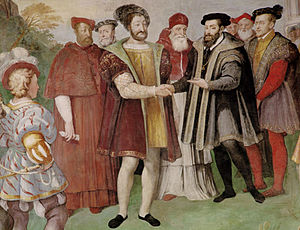Italian War of 1536–1538
| Italian War of 1536–38 | |||||||||
|---|---|---|---|---|---|---|---|---|---|
| Part of the Italian Wars | |||||||||
 The truce of Nice, 1538, between Francis I and Charles V, and mediated by Pope Paul III. Painting by Taddeo Zuccari. |
|||||||||
|
|||||||||
| Belligerents | |||||||||
|
|
|
||||||||
| Commanders and leaders | |||||||||
|
|
|
||||||||
The Italian war of 1536-1538 was a conflict between King Francis I of France and Charles V, King of Spain and Holy Roman Emperor. The objective was to achieve control over territories in Northern Italy, in particular the Duchy of Milan. The war saw French troops invading Northern Italy, and Spanish troops invading France. The Truce of Nice, signed on June 18, 1538, ended hostilities, leaving Turin in French hands but affecting no significant change in the map of Italy. Overall, Spain increased its control over Italy, signifying the end of Italian independence. The war strengthened animosity between the Spanish and French, and reinforced ties between France and the Ottoman Empire which had sided with Francis I against Charles V.
In 1500, Louis XII made an agreement with Ferdinand II on dividing the Kingdom of Naples, as Frederick IV was removed from the Neapolitan throne. This was known as the Treaty of Grenada. This decision was heavily criticized by influential figures such as Niccolo Machiavelli, whose opinion was embraced by many of Italy’s citizens as well. When Charles V came into power in 1519, he gained more of a reputation in Italy, as he joined Spain together with the Holy Roman Empire. The French then invited the Spanish to migrate into Italy.
The war began in 1536 between Charles V and Francis I of France commenced upon the death of Francesco II Sforza, the duke of Milan. Sforza had no children and died of a long and painful illness in 1535. Because he had no heirs, Francesco’s dynasty was brought to an end by Charles V, whose niece, Christina of Denmark, was Francesco’s wife. There were no protests when Charles V took over the Duchy of Milan from either the people or other Italian states. This shift in power marked a new era for France, as Jean de la Foret was brought in as an ambassador to the Ottoman Empire, a territory coveted for its wide range of goods and large amount of power. Foret and Francis I secured an alliance with the Ottoman Empire, giving France a strong and intimidating army, ready to attack desired targets such as Marseille and Piedmont, areas close to the Italian province of Genoa.
...
Wikipedia
